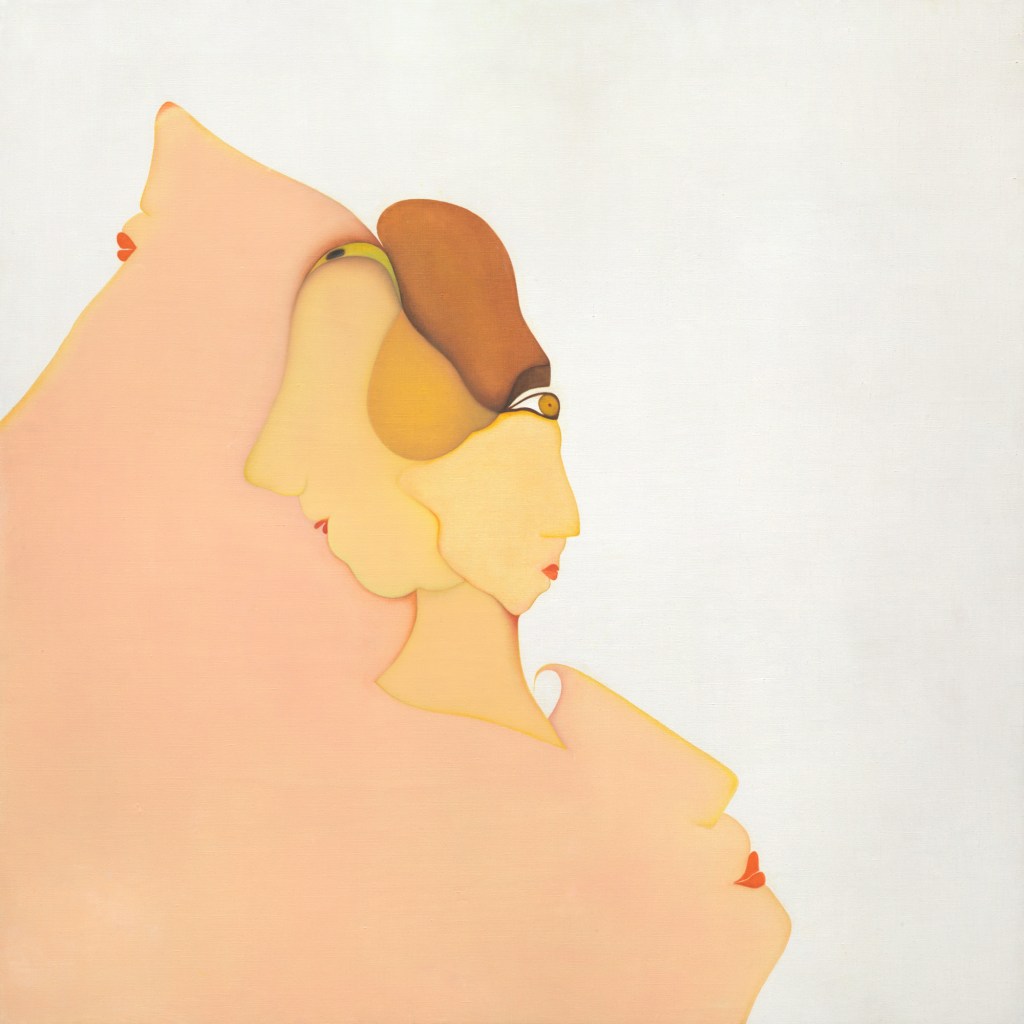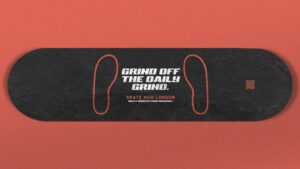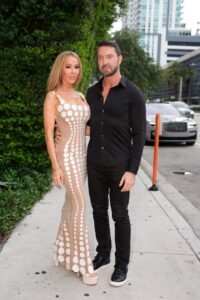How Huguette Caland and Hai-Wen Lin Listen to the Body


CHICAGO — Two of the most delightful solo shows up in Chicago right now concern human bodies. Both are playful and witty, full of bright color and unexpected shapes. One gleefully declares itself corporeal: Huguette Caland’s Bribes de corps, a series of whimsical and abstracted body parts painted in the 1970s, on view at the Arts Club. The other makes no such claims. And yet, Petal Fold, Rabbit Ear, Inside Reverse, an exhibit at Compound Yellow of idiosyncratic origami models recently made by Hai-Wen Lin, has a relationship to human anatomy just as important.
Art need not explicitly state its concerns, though it may. Subtlety and obscurantism fall within the bounds of artistic prerogative, as do boldness and explicitness, and artists have no obligation to choose one mode over another. There are enough reasons to take one’s pick, from aesthetic preference to emotional necessity to political and cultural imperatives.
Caland, who was born in Beirut in 1931, led a life whose forthright, feministic pleasure-seeking radiates from her canvases. The daughter of Lebanon’s first post-independence president, she took up art making in her 30s, left her husband, lover, and children for Paris, found there another lover, collaborated with Pierre Cardin on a line of caftans, and later moved to Venice Beach, California, all along the way keeping her family devoted and her home studio open to social gatherings. Though she struggled professionally for most of her career, she was rediscovered in her 80s, with star turns in various biennials. The interest has only grown since her death in 2019, with retrospectives at the Drawing Center in New York and, just this past summer, at the Reina Sofia in Madrid. Art historian Hannah Feldman, who curated the latter, also put together the Arts Club display, which focuses on Caland’s best known body of work.

Bribes de corps means “body bits” in English, and it is an apt descriptor for most of the 27 canvases included here. Caland painted them between 1968 and 1980, and they are exuberant, amusing, poppish, and sexy. But it’s a silly, clever eroticism, like two large, rosy color field paintings that take a while to reveal that they are also fleshy buttocks sitting on the canvases’ edges, or a small tondo with mysterious black, white, and red shapes that could be a penis meeting a vulva. Several paintings play with the limits of facial and gender recognition, as features resolve from the geometric to the genital to the physiognomic. Or don’t: in any other context, some of these pictures would be plain abstraction, but here two lime blobs on a lemon ground very nearly touch and the effect is electric, like knees grazing under a table. An angular, creamy composition conjures the curve of a torso with a raised arm or maybe a pert breast. A huge white canvas is bordered by a set of quivering, hot pink lines, telling a body-positive joke on hard-edge abstraction and minimalism.
Geometric purists and aesthetic prudes can doubt all they want about the erotic content of the above, but there’s no denying the naughtiness of the tiny scenes Caland doodled with the finest of brushes across a handful of her paintings. Think Shel Silverstein but happier and for adults only. Likewise, her transformation of pale abstract forms, by way of a pair of red lips or some well-placed shading, into something that shifts lustily between face, body, and land mass.

There are also two caftans on view, modeled on sculptural mannequins, that epitomize the paintings’ spirit in dress form. Caland designed many such garments for her own use. “The First Dress” has a collar, sleeves, and hem stitched with colorful amoebic blobs, perhaps because amoebas were some of the earliest life forms; “Tendresse (Dress #5),” embraced by a pair of embroidered arms, is indeed a tender dress.
Sensitive clothing is one way of describing the work for which artist Hai-Wen Lin has begun to be known. The 31-year-old Taiwanese-American artist was a standout in Ground Floor 2024, the Hyde Park Art Center’s biennial round-up of top recent graduates from Chicago’s various MFA programs, for a pair of kites designed for both flying and donning. The fabric, treated with cyanotype solution, bears the traces of its wearer’s body — including a hand across the torso that serendipitously echoes Caland’s caftan. The effect exceeds the obvious ingenuity of the design because of the poetics of the concept, of a body given flight. Other garment-kites of Lin’s creation, each with a unique and touching narrative twist, have featured in local solo shows at Facility and Prairie Gallery.

This is not what Lin presents at Compound Yellow, an artist-run gallery and garden in Oak Park. Petal Fold, Rabbit Ear, Inside Reverse is named for classic origami moves, and it is full of the artist’s unusual origami models. This comes as a surprise, although it is not hard to imagine how well the skills of garment-making and origami relate. The largest model in Petal Fold is the size of a human body, a dainty but dirty figure arranged from a 12-foot-square sheet of plain white paper, featureless, laid out on the floor very still, legs crossed. The most paradoxical works are four pieces of crumpled paper scattered about, except they are identical, meaning they are not crumpled paper at all but rather origami that follow a mind-bendingly intricate pattern to replicate a wad of paper. Casual things can be the hardest to achieve intentionally.
A series of six models, each made from a piece of 2.5-square-foot paper, fold up into unclassifiable shapes that look ready to jump, walk, or fly off their shelves. One is unfolded and framed flat, a generous move that reveals a complex web of creases, dashes of paint that feel instructional, and collaged photographs of watery landscapes, their horizons lined up with individual folds, as if the world were being bent. Each is painted, and named for, the flavor of a Dum-Dum lollipop, including “Mystery,” which of course is purple. The oldest works in the show explain the reference: a handful of tiny action figures folded from those candy wrappers, exactly the kind of thing a kid would make for their own amusement, if that kid were deeply accomplished at origami.

Hai-Wen Lin was just such a kid, and indeed all the larger works in Petal Fold are based on models they invented when they were younger. These got boxed up around the time Lin transitioned, and changed their name, and they’ve only recently been unpacked, during a residency at the Bemis Center in Omaha. The metaphoric potential, which Lin explores in a jewel of an artist text, astounds: Origami as an art of rearrangement, where new things can appear without the need for gluing or cutting, just by careful creasing and tucking, and getting one’s papers in order. Think about that for a moment in terms of the body and gender.
One of the non-origami artworks on view spells it out: 14 pieces of vertical lined paper, bought in Taiwan, on which Lin practiced writing their chosen name over and over again, until a new signature emerged. If you listen deeply, honestly, and playfully to what a body needs, the necessary lines and folds will eventually present themselves. In any case, paper can always be redrawn and refolded.







Huguette Caland: Bribes de corps continues at the Arts Club of Chicago (201 East Ontario Street, Chicago, Illinois) through August 2. The exhibition was curated by Hannah Feldman.
Petal Fold, Rabbit Ear, Inside Reverse: New Works by Hai-Wen Lin continues at Compound Yellow (244 Lake Street, Oak Park, Illinois) through June 29. The exhibition was organized by the gallery.






